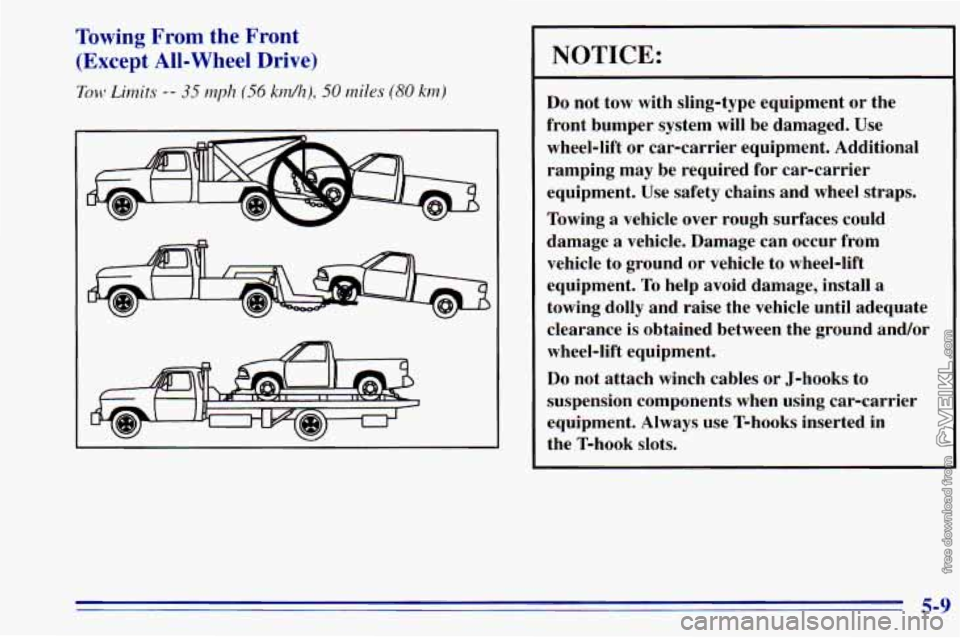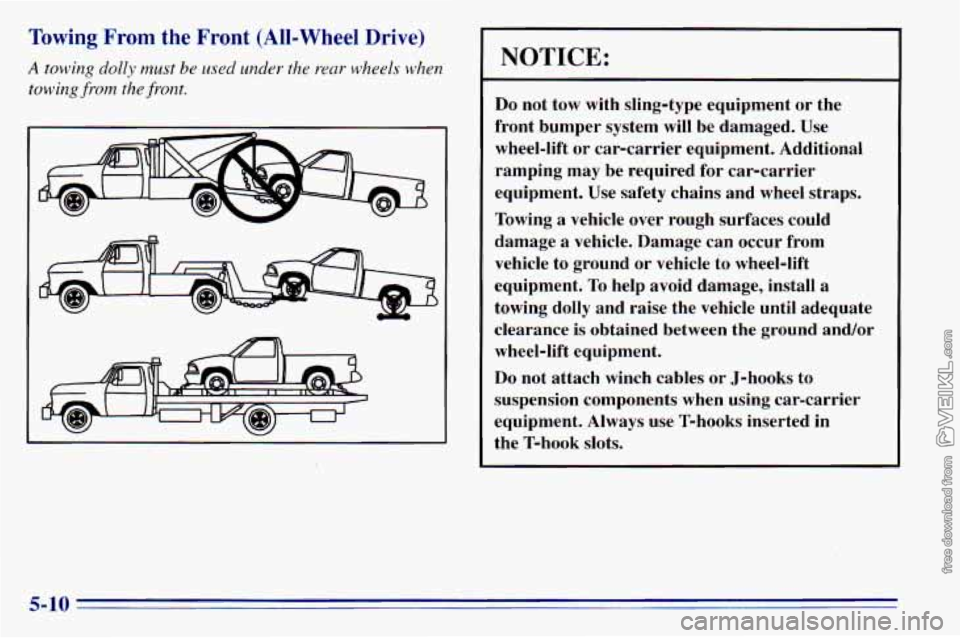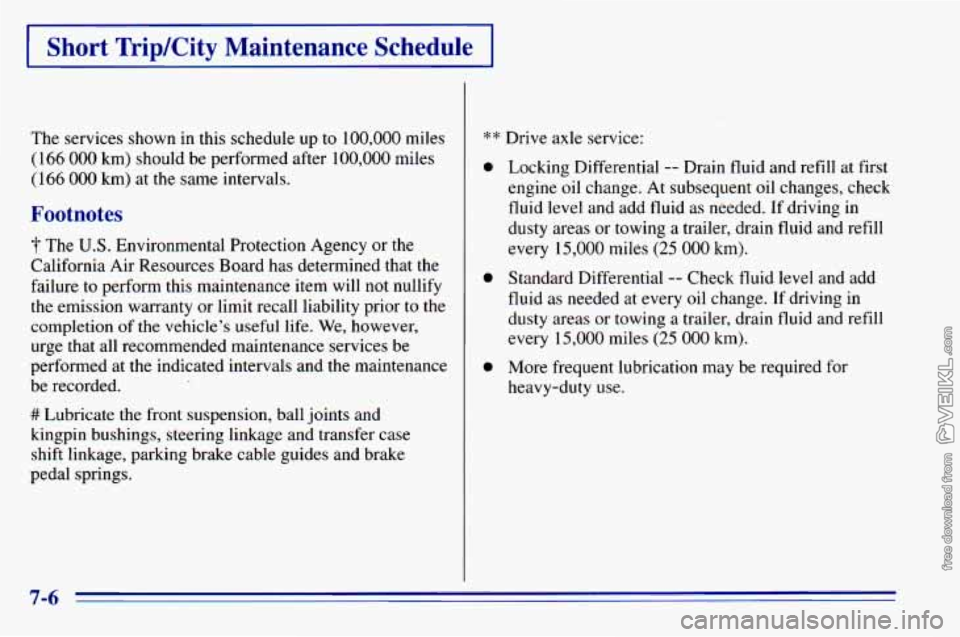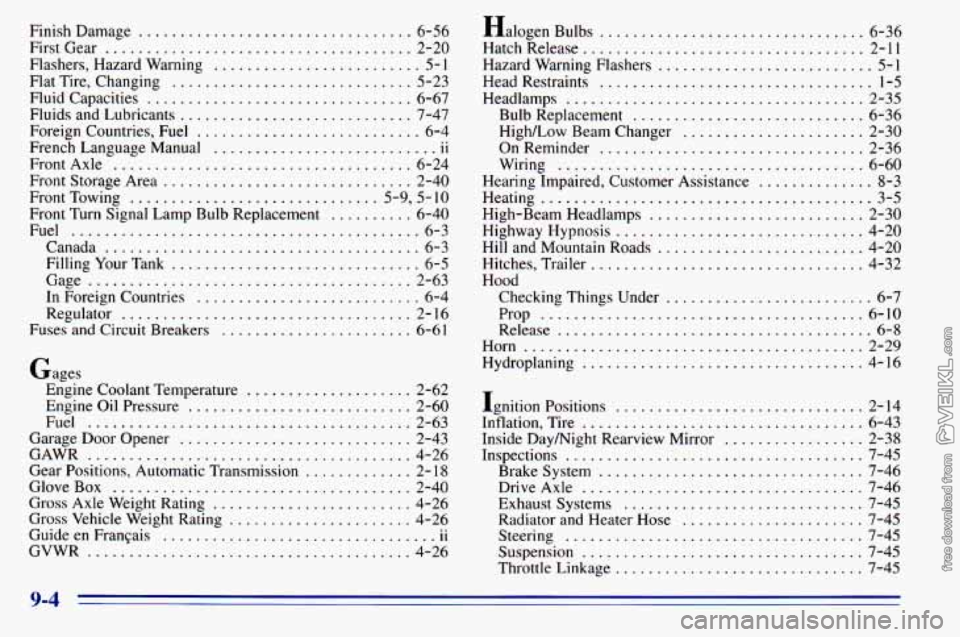suspension CHEVROLET ASTRO 1996 Owners Manual
[x] Cancel search | Manufacturer: CHEVROLET, Model Year: 1996, Model line: ASTRO, Model: CHEVROLET ASTRO 1996Pages: 372, PDF Size: 21.51 MB
Page 181 of 372

Using heavier suspension components to get added
durability might not change your weight ratings. Ask
your dealer
to help you load your vehicle the right way.
I NOTICE:
Your warranty does not cover parts or
components that fail because of overloading,
If you put things inside your vehicle
-- like suitcases,
tools, packages, or anything else
-- they will go as fast
as
the vehicle goes. If you have to stop or turn quickly,
or if there is a crash, they’ll keep going. Things
you put inside your vehicle
and injure people in a sudden stop
or turn, or in
a crash.
0
0
0
0
0
Put things in the cargo area of your vehicle,
Try to spread the weight evenly.
Never stack heavier things, like suitcases, inside the vehicle
so that some of them are
above the tops of the seats.
Don’t leave an unsecured child restraint in
your vehicle,
When you carry something inside the
vehicle, secure it whenever you can.
Don’t leave
a seat folded down unless you
need to.
4-27
Page 201 of 372

Towing From the Front
(Except All-Wheel Drive)
Tow Limits -- 35 mp11 (56 krnh), 50 rniles (80 km)
NOTICE:
Do not tow with sling-type equipment or the
front bumper system will be damaged. Use
wheel-lift or car-carrier equipment. Additional
ramping
may be required for car-carrier
equipment. Use safety chains and wheel straps.
Towing
a vehicle over rough surfaces could
damage a vehicle. Damage can occur from
vehicle to ground or vehicle to wheel-lift
equipment. To help avoid damage, install
a
towing dolly and raise the vehicle until adequate
clearance
is obtained between the ground and/or
wheel-lift equipment.
Do not attach winch cables or J-hooks to
suspension components when using car-carrier
equipment. Always use T-hooks inserted in
the T-hook slots.
Page 202 of 372

Towing From the Front (All-Wheel Drive)
A towing dolly must be used under the rear wheels when
towing front the front.
NOTICE:
Do not tow with sling-type equipment or the
front bumper system will be damaged. Use
wheel-lift or car-carrier equipment. Additional
ramping may be required
for car-carrier
equipment. Use safety chains and wheel straps.
Towing a vehicle over rough surfaces could
damage a vehicle. Damage can occur from
vehicle to ground or vehicle
to wheel-lift
equipment. To help avoid damage, install a
towing dolly and raise the vehicle until adequate
clearance is obtained between the ground and/or
wheel-lift equipment.
Do not attach winch cables or J-hooks to
suspension components when using car-carrier
equipment. Always use T-hooks inserted in
the T-hook slots.
5-10
Page 306 of 372

Short Trip/City Maintenance Schedule
The services shown in this schedule up to 100,000 miles
(166
000 km) should be performed after 100,000 miles
(166
000 km) at the same intervals.
Footnotes
3- The U.S. Environmental Protection Agency or the
California Air Resources Board has determined that the
failure
to perform this maintenance item will not nullify
the emission warranty or limit recall liability prior
to the
completion
of the vehicle’s useful life. We, however,
urge that all recommended maintenance services be
performed at the indicated intervals and the maintenance
be recorded.
# Lubricate the front suspension, ball joints and
kingpin bushings, steering linkage and transfer case
shift linkage, parking brake cable guides and brake
pedal springs. Drive
a
a
a
a
lxle service:
Locking Differential
-- Drain fluid and refill at first
engine oil change. At subsequent oil changes, check
fluid level and add fluid as needed. If driving in
dusty areas or towing a trailer, drain fluid and refill
every
15,000 miles (25 000 km).
Standard Differential
-- Check fluid level and add
fluid as needed
at every oil change. If driving in
dusty areas or towing a trailer, drain fluid and refill
every
15,000 miles (25 000 km).
More frequent lubrication may be required for
heavy-duty use.
7-6
Page 329 of 372

Long Tripmighway Maintenance Schedule
The services sbown in this schedule up to 100,000 miles
(166
000 km) should be performed after 100,000 miles
(166 000 km) at the same, intervals.
Footnotes
The U.S. Environmental Protection Agency or the
California Air Resources Board has determined that the
failure to perform this maintenance item will not
nullify
the emission warranty or limit recall liability prior to the
completion of the vehicle’s useful life. We, however,
urge that all recommended maintenance services be
performed at the indicated intervals and the maintenance
be recorded.
# Lubricate the front suspension, ball joints and
kingpin bushings, steering linkage and transfer case
shift linkage, parking brake cable guides and brake
pedal springs.
** Drive axle service:
0
0
0
Locking Differential -- Drain fluid and refill at first
engine
oil change. At subsequent oil changes, check
fluid level and add fluid as needed. If driving in
dusty areas or towing a trailer, drain fluid and refill
every
15,000 miles (25 000 km).
Standard Differential
-- Check fluid level and add
fluid as needed at every engine
oil change. If driving
in dusty areas or towing a trailer, drain fluid and
refill every 15,000 miles
(25 000 km).
More frequent lubrication may be required for
heavy-duty use.
7-29
Page 345 of 372

Part C: Periodic Maintenance
Inspections
Listed below are inspections and services which should
be performed
at least twice a year (for instance, each
spring and fall). You should let your GM dealer’s
service department or other qualified service center do
these jobs. Make sure any necessary repairs are
completed at once.
Proper procedures to perform these services may be
found
in a GM Service Manual. See “Service and Owner
Publications’’
in the Index.
Steering and Suspension Inspection
Inspect the front and rear suspension and steering
system for damaged, loose or missing parts, signs of
wear or lack of lubrication. Inspect the power steering
lines and hoses for proper hook-up, binding, leaks,
cracks, chafing, etc.
Exhaust System Inspection
Inspect the complete exhaust system. Inspect the body
near the exhaust system. Look for broken, damaged,
missing or out-of-position parts as well as open seams,
holes, loose connections
or other conditions which could
cause a heat build-up
in the floor pan or could let
exhaust fumes into the vehicle. See “Engine Exhaust’’
in the Index.
Radiator and Heater Hose Inspection
Inspect the hoses and have them replaced if they are
cracked, swollen or deteriorated. Inspect all pipes,
fittings and clamps; replace as needed.
Throttle Linkage Inspection
Inspect the throttle linkage for interference or binding,
and for damage or missing
parts. Replace parts as
needed. Replace any cables
that have high effort or
excessive wear.
Do not lubricate accelerator and cruise
control cables.
7-45
Page 364 of 372

Finish Damage ................................. 6-56
First Gear
..................................... 2-20
Flashers. Hazard Warning
......................... 5-1
Flat Tire. Changing ............................. 5-23
Fluid Capacities
................................ 6-67
Fluids and Lubricants
............................ 7-47
Foreign Countries. Fuel
........................... 6-4
French Language Manual
11
Front Axle .................................... 6-24
Front Storage Area
.............................. 2-40
Front Towing
.............................. 5-9. 5- 10
Front Turn Signal Lamp Bulb Replacement .......... 6-40
Fuel
.......................................... 6-3
Canada
...................................... 6-3
Filling Your Tank
.............................. 6-5
Gage
....................................... 2-63
In Foreign Countries
........................... 6-4
Regulator
................................... 2-16
Fuses
and Circuit Breakers ....................... 6-61
Gages
.. ...........................
Engine Coolant Temperature .................... 2-62
Engine Oil Pressure
........................... 2-60
Fuel
....................................... 2-63
Garage Door Opener
............................ 2-43
Gear Positions. Automatic Transmission
............. 2- 18
GloveBox .................................... 2-40
Gross Axle Weight Rating
........................ 4-26
Gross Vehicle Weight Rating
...................... 4-26
Guide en FranGais
11
GVWR ....................................... 4-26
GAWR
....................................... 4-26
.. .................................
Halogen
Bulbs ................................ 6-36
Hatch Release
.................................. 2-11
Hazard Warning Flashers .......................... 5-1
Head Restraints ................................. 1-5
Headlamps .................................... 2-35
Bulb Replacement
............................ 6-36
Highkow Beam Changer
...................... 2-30
OnReminder
................................ 2-36
Wiring
..................................... 6-60
Hearing Impaired. Customer Assistance
.............. 8-3
Heating ........................................ 3-5
High-Beam Headlamps
.......................... 2-30
Highway Hypnosis
.............................. 4-20
Hill and Mountain Roads
......................... 4-20
Hitches. Trailer
................................. 4-32
Hood Checking Things Under
......................... 6-7
Prop
....................................... 6-10
Release
...................................... 6-8
Horn
......................................... 2-29
Hydroplaning
.................................. 4-16
Ignition Positions
.............................. 2-14
Inflation. Tire
.................................. 6-43
Inside Daymight Rearview Mirror
................. 2-38
Inspections
.................................... 7-45
Brakesystem
................................ 7-46
Drive Axle
.................................. 7-46
Exhaust Systems
............................. 7-45
Radiator and Heater Hose
...................... 7-45
Steering
.................................... 7-45
Suspension
.................................. 7-45
Throttle Linkage
.............................. 7-45
9-4